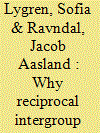| Srl | Item |
| 1 |
ID:
142528


|
|
|
|
|
| Summary/Abstract |
The concept of “cumulative extremism”—described in 2006 by Roger Eatwell as “the way in which one form of extremism can feed off and magnify other forms [of extremism],” has recently gained considerable traction in academic, policy, and practitioner discourses about extremism. Yet in spite of the growing usage of the term, particularly in analyses of the dynamic between extreme Islamist and extreme Right-Wing or anti-Muslim protest groups, there has to date been scant interrogation of the concept itself or of its application. In this article, we make a series of six proposals as to how we might enhance the conceptual clarity of these conversations about “cumulative extremism.” Our aim in doing so is to increase the likelihood that the concept might become a useful addition to the debates on extremism rather than becoming, to borrow a term from John Horgan—something of an “explanatory fiction”—an idea that appears to enable us to explain a great deal, but whose explanatory value is largely lost because there is insufficient scrutiny of the claims that it is used to make and whose liberal application becomes increasingly conducive to poor science.
|
|
|
|
|
|
|
|
|
|
|
|
|
|
|
|
| 2 |
ID:
190971


|
|
|
|
|
| Summary/Abstract |
Between 2009 and 2015, both Islamist and anti-Islamist protest groups were active in Britain and Norway. However, while these opposing groups regularly clashed violently in the U.K., such interactions never occurred in Norway. This paper seeks to explain why seemingly similar group dyads produced different outcomes in different cases. In doing so, we trace relevant causal mechanisms derived from social movement theory in a comparative case study design. The paper can also be read as a response to Busher and Macklin’s call for improving conceptual clarity in research on “cumulative extremism.” Part of our response is introducing an alternative concept: Reciprocal intergroup radicalisation (RIR). Our analysis further shows that in Britain, RIR was fuelled by the presence of militant activists on both sides, a competent leadership, a central enemy image of the adversary, and a perception of unjust repression by security authorities. Conversely, the absence of these factors contained RIR between the Norwegian groups. In conclusion, our paper cautions against exaggerating the threat from RIR as multiple conditions must combine for RIR to occur. Even in Britain, by many considered a hotbed for RIR, the combined presence of these conditions was short lived.
|
|
|
|
|
|
|
|
|
|
|
|
|
|
|
|